The polar dinosaurs revealing ancient secrets
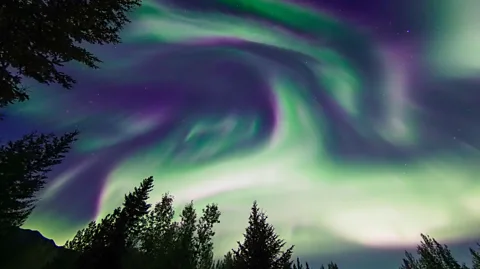 Alamy
AlamyThere's mounting evidence that some dinosaurs lived among snow and ice. How did they do it?
It was the middle of winter under a moody Alaskan sky. On one side stretched the flat expanse of the Colville River. On the other, a soaring cliff face of frozen pewter-grey rock, backing onto hundreds of miles of desolate tundra.
Armed with an ice-axe and crampons, buffeted by frigid Arctic winds in temperatures that hovered around -28C (-20F), Pat Druckenmiller was searching for something special.
It was 2021 and just getting to the cliff had been an extreme expedition. In this remote northerly corner of Alaska, there are no roads, so the palaeontologist and colleagues from the University of Alaska travelled to the site on snow scooters, then set up a camp nearby. It was so cold, each tent was equipped with its own wood-burning stove. For the coming weeks, the team would be constantly battling frostbite – "we had some close calls," says Druckenmiller – rockfalls, and hungry polar bears. But it was worth it.
Squinting through ski goggles in the dusky light, Druckenmiller finally found what he was looking for. Buried within the cliff strata, around 50ft (15m) above the river, was a single layer of clay and sand, about 10cm (4in) thick.
Around 73 million years ago, when the sediment was laid down, the world was warmer than it is now, but the region would have been even further north. While today this part of Alaska gets a few hours of twilight each day during the winter, back then it was plunged into total darkness for four months of the year, from October to February. It regularly dipped below -10C (14F), with occasional dustings of snow.
And yet, hidden within this silty seam are the last remains of a bizarre epoch in history – tiny bones and teeth, mere millimetres across, that belonged to the offspring of giants. This is where thousands of dinosaurs made their nests, and the unhatched foetuses that didn't make it are still there to this day.
"It's probably the most interesting layer of dinosaur bones in the entire state of Alaska," says Druckenmiller. "They were practically living at the North Pole."
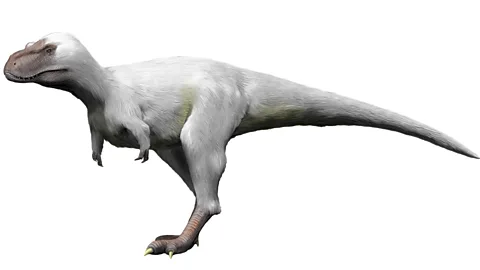 Alamy
AlamyThough we tend to think of dinosaurs as tropical creatures – monstrous, toothy reptiles that patrolled the world's forests and swamps when the planet was warm and wet, scientists are increasingly realising that this is not entirely correct. There were dinosaurs in cooler places too, and it's becoming clear that they were far from occasional, fair-weather visitors.
From Australia to Russia, scientists have now unearthed tens of dinosaurs that may have once lived at frigid extremes – closing their beady, hawk-like eyes under skies filled with dancing aurora light displays each night, and sometimes foraging for food among blankets of pristine silver snow. These dinosaurs weren't just clinging on in at the fringes of their habitable range – in places like Alaska, they were thriving.
The findings have implications far beyond the strange scenes they conjure – with tyrannosaurs shaking the snow off their (possible) feathers, or fluffing themselves up to wait out a blizzard. With each new discovery, polar dinosaurs are revealing fascinating insights into the group's physiology and behaviour. And as scientists learn more about them, they're helping to answer one of the most intractable questions in palaeontology: were dinosaurs warm or cold-blooded?
A surprise discovery
In 1961, Robert Liscomb was mapping the banks of the Colville River for the oil company Shell, when he found something unexpected: a handful of bones, sticking out of the strata of the cliff. He assumed they must be from mammals, but took them with him anyway and put them in a cupboard. The same year, he was tragically killed in a rockfall.
For two decades, the bones were forgotten, safely locked away in storage at the company's archives. Meanwhile, scatterings of dinosaur fossils began emerging in other northerly locations, including footprints on the Norwegian island of Svalbard.
 Alamy
AlamyThen one day, in 1984, there was an exciting discovery: scientists had uncovered skin impressions and footprints from dinosaurs along the very same northern slope of the Colville River where Liscomb found his. With this in mind, the old bones were rapidly retrieved from their drawer – and revealed to have belonged to dinosaurs all along. This ignited a fierce debate among palaeontologists. Surely there couldn't really have been cold-blooded animals this far north? Century-old assumptions were being called into question, and things were getting heated.
But before long, it became clear that the Colville River bones had been no fluke – the outcrops along its banks were positively teeming with dinosaur fossils, more than had been found at any other Arctic or Antarctic location on the planet. "And most importantly, it's far and away the most polar dinosaur site," says Druckenmiller.
As the finds added up, eventually the evidence became overwhelming. Even in those early days, there were abundant fossils from the cow-like herbivore Edmontosaurus and an unidentified relative of Triceratops, as well as a single tooth from the predator Alectrosaurus – a tyrannosaur about the size of the average walrus.
There had indeed been polar dinosaurs, though how they survived remained to be understood. Luckily there was an easy explanation: they only lived there when it was warm – they migrated. Just like their distant cousins, modern-day Arctic terns, the animals may have visited the poles during the summer, then retreated to warmer climates during the winter. Some experts suggested that they travelled up to 3,200km (1,988 miles).
Then this theory also hit a snag.
On a cool summer's day in the Late Cretaceous, a mega-herd of hadrosaurs crossed a muddy floodplain in the Arctic. It was around 10-12C (50-54F), and the cow-like herbivores – equipped with toothless beaks for grinding vegetation and massive, fleshy tails – had just survived a harsh winter in which temperatures dipped to almost freezing. There were thousands of individuals of all ages – juveniles, teenagers and adults.
Their promenade across the mud may only have lasted minutes, but the tracks they left were soon covered with further sediment, and preserved for the coming millennia – until they were found by scientists in 2014. The footprints were so well preserved, it was even possible to make out the scales on the dinosaurs' feet.
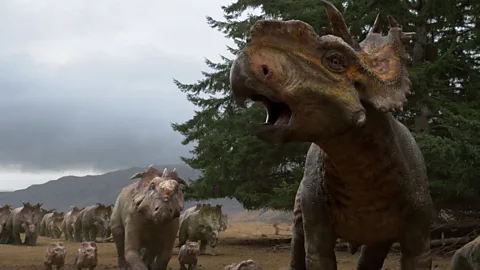 Alamy
AlamyThe fossils were located in an Alaskan nature reserve, hundreds of miles further south than the Colville bone beds, but still within the Arctic. The presence of tracks from young dinosaurs hinted that they probably remained in the region year-round after all – the smallest ones would not have been able to cope with a long migration.
However, not everyone was convinced. Enter Druckenmiller and his painstakingly located band of rock.
A tricky task
While some palaeontologists were digging up thigh bones the size of dolphins in the sun-baked Badlands of South America, Druckenmiller's approach was necessarily different.
When the team first started working on the Coleville River site in Alaska, they would visit in the summer, when today it's around 1-10C (34-50F). They quickly discovered that this was far from ideal. Between June and August, Alaska is swarming with mosquitoes – giant clouds that bear down upon unsuspecting humans like blizzards of black snow. There are so many, they're playfully referred to as the Alaska state bird. But this was the least of their worries.
The cliff faces they worked on were mostly composed of muddy rock loosely glued together by permafrost. "And there's just enough warming in the summer for some of that ice to melt so these cliffs can catastrophically just collapse. If you're standing under one of those, it's game over," says Druckenmiller.
The scientists decided to go in the winter instead, which presented its own problems. They were working just 20 miles (32km) from the Arctic Ocean – it was simply too cold to lie on their stomachs all day while sifting out the bones of baby dinosaurs. Instead, soon after the team had found their long-anticipated rock layer, the silence of the empty landscape was promptly broken with the sound of chainsaws and jackhammers.
First the team cut some steps into the cliff so they could traverse it, then set to work carving out whole blocks of promising-looking sediment, rather than specific bones. These were loaded onto sleds and snowmobiles, and driven back hundreds of miles across the frozen tundra to the laboratory.
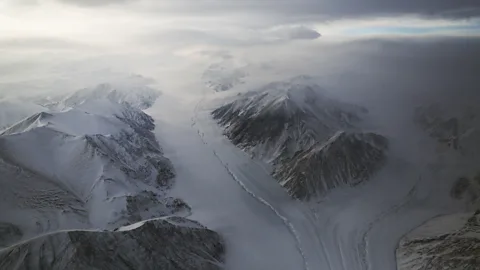 Getty Images
Getty ImagesOnce these massive samples were safely at the University of Alaska, they were washed to screen out the clay. "And then what's left is basically like a sand fraction – we look at every single grain of sand under a microscope for little bones and teeth," says Druckenmiller, "This is a very slow, time-consuming process. It's kind of just like panning for gold except for dinosaurs instead." Over the course of a decade, he estimates that his team has looked at millions of sand particles in the search for these tiny fossils.
What the team found was extraordinary. "We didn't have just one or two kinds of baby dinosaurs, we actually have evidence for seven different groups of dinosaurs, including plant-eaters and meat-eaters, small species and large species," says Druckenmiller.
Importantly, the fact that the dinosaurs were nesting means they almost certainly weren't migrating away when it got colder. Some common species of dinosaurs, such as the duck-billed hadrosaurs, needed six months to incubate their eggs – so if the mothers started sitting on them in the spring, it would be almost winter by the time they hatched.
To nest in the Arctic but avoid the winter with its months of darkness, these babies would have had to somehow immediately migrate thousands of miles. There just wasn't enough time. "It defies logic. We're pretty sure that these dinosaurs were year-round residents," says Druckenmiller.
So what would life have been like for these polar dinosaurs? And how did they manage to survive?
An icy mystery
It was early March in the Late Cretaceous, at the open Arctic woodland that would eventually become the site of the Colville River. The bare branches of conifers and ancient gingko trees were just coming into bud, casting dappled shade over an understorey of ferns and horsetails below. Herds of hadrosaurs browsed absent-mindedly on the foliage, while male Pachyrhinosaurus, stocky relatives of triceratops, paraded their extravagant neck frills in the hope of attracting a mate – perhaps snorting occasionally through their long, bulbous noses.
Occasionally the relative calm might be punctuated with a chase and a squawk – a hungry Nanuqsaurus, or "polar bear lizard", had managed to catch a scaly, beaky Thescelosaurus in its jaws. With blood dripping down the soft coat of snow-white feathers it's sometimes depicted with, it could have looked remarkably like its modern namesake.
Nearby were a number of nests – possibly at communal nurseries, if the dinosaurs were like their southerly relatives – where the local residents incubated their eggs. Bird-like relatives of velociraptors, saurornitholestines, settled themselves over their broods and may have used their specialised teeth to preen their feathers.
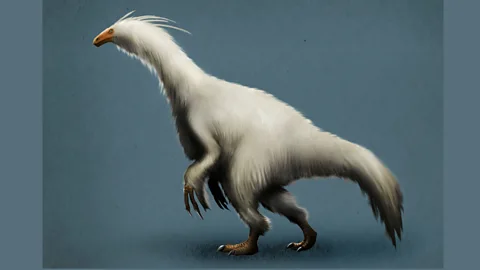 Alamy
AlamyOver decades or hundreds of years, some of the dinosaurs that died in the area ended up being washed into a nearby river or lake. "But the sediment was winnowed away in such a way as to concentrate these bones and teeth into these little discrete deposits," says Druckenmiller.
A number of the dinosaurs identified in silt from sites along the Colville River have been found nowhere else, such as Ugrunaaluk kuukpikensis, "ancient grazer" in the local Inupiat language – a kind of hadrosaur. Of course, this doesn't mean they won't be eventually, and it doesn't necessarily prove that they had any special adaptations to the cold either. But it's promising.
Druckenmiller thinks it's likely that the Alaskan dinosaurs had at least some distinguishing features, such as behaviours that evolved to help them cope in Arctic conditions. "There's reason to believe that maybe some of the smaller species, especially the plant-eaters, maybe some of these were small enough to make a burrow and hibernate over the winter," he says.
These tentative hints come from growth rings in cross sections of bone, like those in tree trunks – markings that show how the animal's growth pattern varied from year to year. If growth stops, such as during hibernation, the gap leaves a ring. According to Druckenmiller, these distinctive bands have been found in several dinosaurs from the slopes of the Colville River, some of which may have hibernated. This adds to the evidence from elsewhere that dinosaurs may have had at least some of the adaptations required, such as burrowing.
In 2007, the fossilised skeleton of an Oryctodromeus – a dinosaur around the size of a german shepherd - was found alongside two of its young in a cosy little hole in south-west Montana. The whole lot had become entombed and lain there undisturbed for around 100 million years. They're part of the Thescelosaurus genus, members of which have also been found at the Colville River site.
"And the fact that we have close relatives in Alaska suggests that it could be that these species also burrow but to hibernate," says Druckenmiller. Unfortunately, proving this would be extremely difficult, short of finding another burrow in the Arctic.
 Alamy
AlamyAnother possibility is that dinosaurs coped with the cold much like many modern-day mammals do, by building up a layer of body fat. Druckenmiller gives the example of moose and caribou, which pile on the weight each summer, then survive on a combination of their fat reserves and low-quality forage in the winter when food is sparse – a strategy which has the added bonus of keeping them warm. "…they do it by basically slowly starving," he says. "There's no reason why dinosaurs couldn't have done that."
But there is one adaptation that is more clear-cut: how dinosaurs regulated their body temperature.
Scientists have been debating whether dinosaurs were warm or cold-blooded ever since they were discovered. In the 19th Century, it was widely assumed that they were essentially massive, ectothermic reptiles – they couldn't generate their own body heat, and needed to sunbathe like modern ones. When the iconic Crystal Palace dinosaur sculptures were unveiled in London in 1854, they resembled stocky, scaly lizards.
But as experts learned more about dinosaur lives – and began to realise that modern birds are essentially beaky, feathered dinosaurs – many began to question whether this was accurate. Eventually they formed a consensus that dinosaurs probably maintained temperatures somewhere between reptiles and birds, and yet until recently, hard evidence was still somewhat lacking.
Arctic dinosaurs change all this. "One of the things we assume in this whole story is these dinosaurs were almost certainly warm-blooded, to some extent," says Druckenmiller. "Certainly these dinosaurs had some degree of endothermy – they were producing their own internal heat. And that's kind of a prerequisite for living in a cold environment."
Strikingly, no fossilised remains of reptiles have ever been found in the Alaskan fossil beds – only birds, mammals and dinosaurs. "Now if you work in Montana, and you're looking for dinosaurs, along the way, you're going to find crocodilians, turtles, lizards… we have never ever found a scrap of any of those cold-blooded groups," says Druckenmiller.
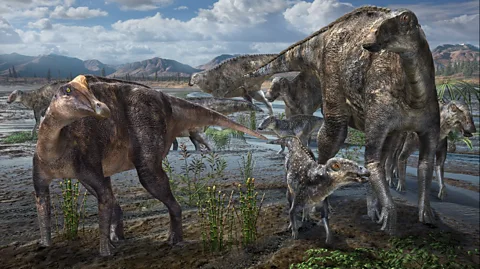 Wikimedia Commons/ Masato Hattori
Wikimedia Commons/ Masato HattoriNot all dinosaurs were necessarily warm-blooded, of course. There's evidence that their body temperatures may have varied by as much as 17C (31F) depending on the group, from as little as 29C to 46C (115-84F). For comparison, most mammals lie in the range of 36 to 40C (97-104F), while birds are significantly warmer, spanning 41 to 43C (105-109F).
But nevertheless, the implications are huge. Endothermic animals typically share certain characteristics, such as faster growth rates and a requirement for more food. But crucially, it was thought this is what allowed some groups to survive the global cooling historically blamed for the dinosaurs' extinction. If the mammals and birds could handle it, why not the Arctic dinosaurs?
As the evidence for Alaskan dinosaurs began to mount in the 1980s, scientists were already realising that they might need another explanation. Today it's thought that the real reason most went extinct is their size, which meant they simply required more food than was available. The exception was the "maniraptoran", or "seizing hands" dinosaurs. The smallest, feathered members of this group – those that weighed about a kilogram (2.2lbs) – were able to cling on and adapt. Now we know this lineage as birds.
With each new discovery, these almost-polar dinosaurs are revealing clues to the diversity and resilience of their relatives across the planet – and showing that they were so much more than giant lizards.
*Zaria Gorvett is a senior journalist for BBC Future and tweets @ZariaGorvett
--
